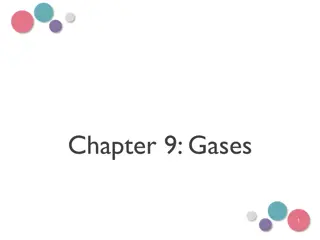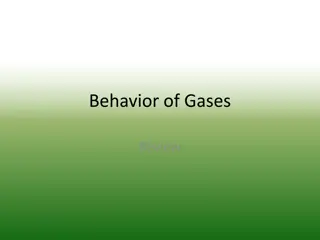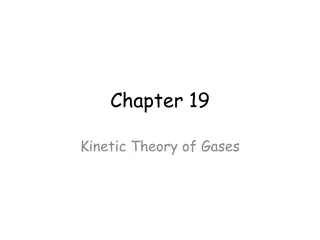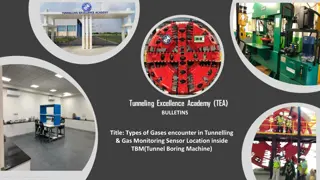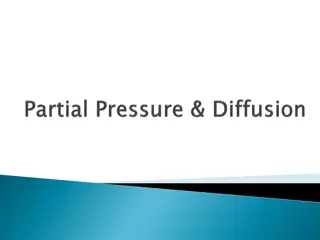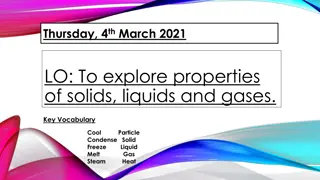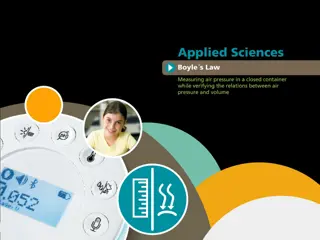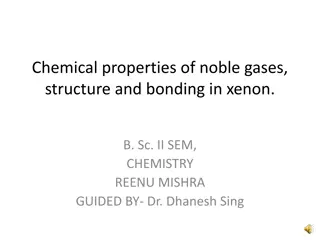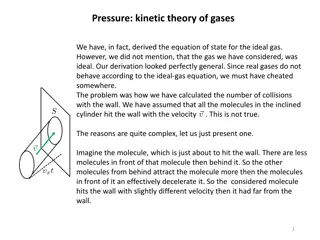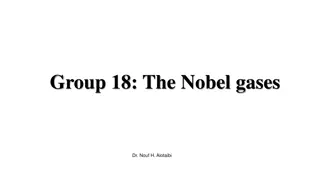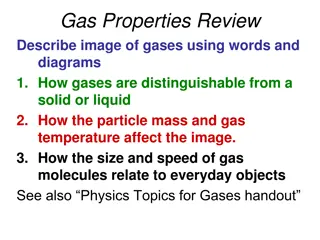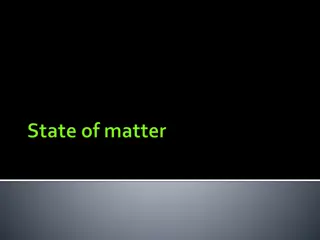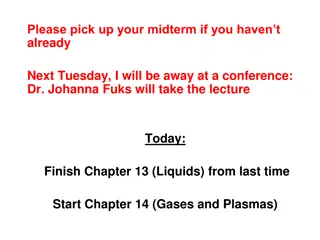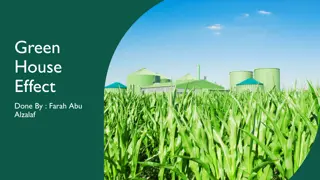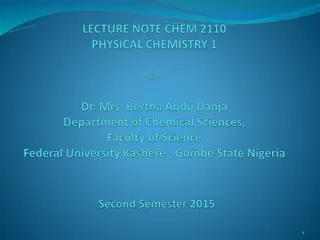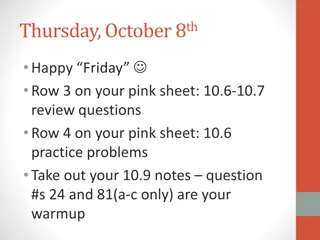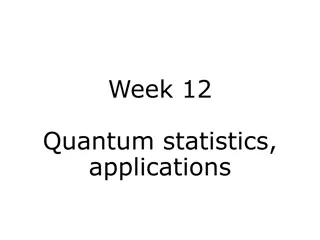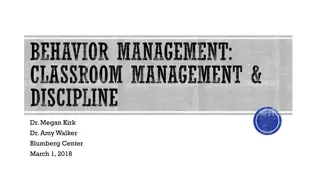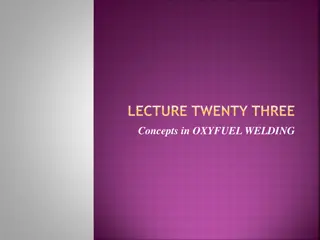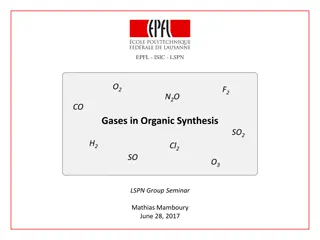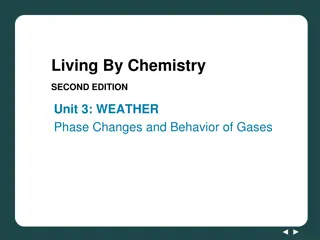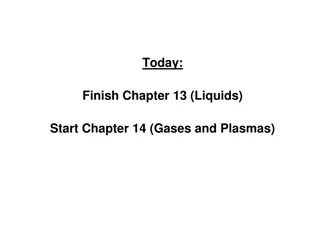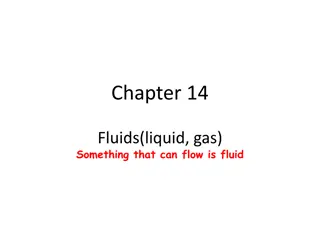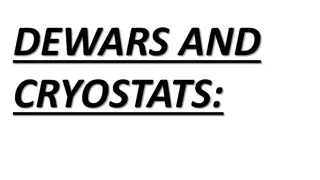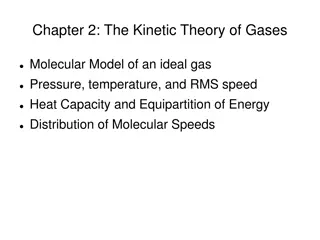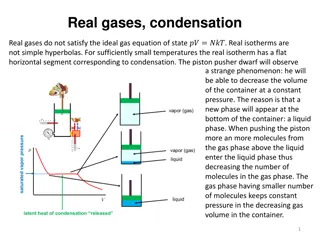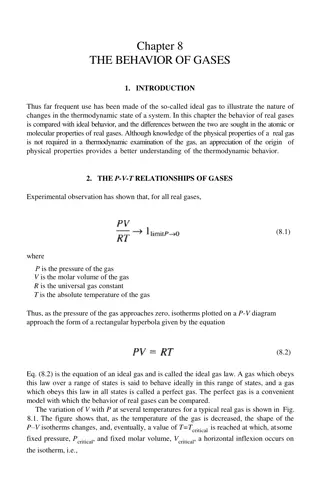Understanding the States of Matter: Solids, Liquids, and Gases
Matter is anything that occupies space and has mass, consisting of tiny particles like atoms and molecules. Solids have closely packed particles, liquids have less densely packed particles that can flow, and gases have spread out particles. Solids retain their shape, liquids take the shape of their
6 views • 11 slides
Understanding Properties of Gases and Gas Laws
Gases exhibit unique properties compared to solids and liquids, including compressibility and variable densities. Pressure is defined as force per unit area, with common pressure units like atm, mmHg, and torr. Gas laws such as Gay-Lussac's Law, Boyle's Law, and Charles's Law describe the relationsh
4 views • 33 slides
Gas Behavior Review
Review key concepts related to the behavior of gases, including characteristics of gases, properties at standard conditions, the kinetic molecular theory, and factors affecting gas pressure. Test your knowledge with true or false questions and learn about gas compression, gas movement in aerosol can
0 views • 17 slides
Understanding Kinetic Theory of Gases: Key Concepts and Equations
Exploring the kinetic theory of gases, this content covers essential concepts such as ideal gas behavior, molar mass, the equation of state, and isobaric/isothermal processes. Discover the relationship between pressure, volume, and temperature in gases, along with practical examples and calculations
0 views • 49 slides
Types of Gases in Tunnelling & Gas Monitoring Sensors in TBM
Understanding the types of gases encountered in tunnelling is crucial for safety. Gases like carbon monoxide, carbon dioxide, nitrogen oxides, methane, and hydrogen sulfide are common in TBM environments. Proper gas monitoring sensor placement inside the TBM is essential to detect hazardous gas leve
0 views • 11 slides
Gas Laws and Properties: Understanding the Behavior of Gases
Gas laws govern the behavior of gases and their properties in various conditions. From the total pressure of gas mixtures to calculating partial pressures, understanding the relationship between pressure, volume, temperature, and amount of gas is crucial. Effusion and diffusion play key roles in how
0 views • 16 slides
Exploring Properties of Matter: Solids, Liquids, and Gases
Dive into the characteristics of solids, liquids, and gases through engaging visuals and key vocabulary. Understand the behavior of particles in different states of matter and learn about the properties that define each state. Explore examples of solids, liquids, and gases with a focus on their uniq
0 views • 19 slides
Electrical Breakdown in Gases, Solids, and Liquids: Understanding the Phenomenon
Exploring the intricate dynamics of electrical breakdown in various mediums such as gases, solids, and liquids. From the criteria for breakdown in gases to factors affecting breakdown strength in liquid dielectrics, this study delves into the mechanisms, equations, and practical implications of thes
0 views • 15 slides
Investigating Boyle's Law: The Relationship Between Air Pressure and Volume
Explore the fascinating relationship between air pressure and volume of a confined gas at constant temperature through an experiment testing Boyle's Law. Learn about the historical context and theoretical foundation behind the behavior of gases, including the concept of ideal gases and the Boyle-Mar
0 views • 24 slides
Chemical Properties and Bonding in Xenon: A Study of Noble Gases
Noble gases, including xenon, exhibit unique chemical properties due to their stable electron configurations. Xenon forms compounds like xenon difluoride, xenon tetrafluoride, and xenon hexafluoride, showcasing various hybridization states and geometries. These compounds illustrate the reactivity of
0 views • 18 slides
Understanding Activity and Fugacity in Gases
Fugacity of real gases can be measured, defining standard states in terms of fugacity. The relation between fugacity, activity, and molar concentration is explored, highlighting the ideal behavior of gases at standard states. Activity coefficients and deviations from ideal gas behavior are also disc
0 views • 30 slides
Insight into Kinetic Theory of Gases and Maxwell Velocity Distribution
The discussion delves into the kinetic theory of gases, highlighting the deviations from ideal gas behavior and the derivation of the Maxwell velocity distribution. It explores the intricacies of molecule-wall collisions, Maxwell's assumptions, the Gaussian distribution, and the concept of reversibl
0 views • 8 slides
The Noble Gases: Properties, Sources, and Uses
The noble gases, including helium, neon, argon, krypton, xenon, radon, and Oganesson, are characterized by their low reactivity due to a complete electron configuration. They have diverse applications, such as forming inert atmospheres, medical treatments, and lighting technologies. Naturally occurr
0 views • 16 slides
Understanding Gas Properties Through Visual Representation
Explore the characteristics of gases through illustrations and diagrams. Learn how gases differ from solids and liquids, and understand the effects of particle mass and temperature on gas behavior. Discover the relationship between the size and speed of gas molecules in comparison to everyday object
1 views • 26 slides
Understanding Human Behavior: Foundations and Factors
Human behavior is a multifaceted subject influenced by genetic makeup, culture, and individual values. It encompasses both overt actions and covert thoughts, a product of the individual and environmental factors. Psychologists study behavior from visible (overt) actions like playing football to inne
0 views • 20 slides
Understanding the States of Matter and Properties of Gases
Matter can be classified into gas, liquid, and solid based on particle arrangement, shape, and motion. Gases in pharmacy are crucial for various applications like anesthesia and aerosols. Properties of gases include compressibility, pressure exertion, diffusion, and expansion. Gas laws such as Boyle
0 views • 22 slides
Understanding Normal and Abnormal Behavior: Perspectives and Definitions
Normal behavior varies from person to person and society, influenced by individual preferences and societal norms. Abnormal behavior is characterized by an inability to function effectively or personal discomfort. The concept of normality and abnormality in psychology raises complex questions about
2 views • 8 slides
Understanding Gases and Plasmas in the Atmosphere
Delve into the concepts of gases and plasmas in the atmosphere, exploring topics such as fluid pressure, buoyancy, and the unique properties of gases compared to liquids. Discover how the balance between kinetic energy and gravity determines the thickness of our atmosphere and why it is essential fo
0 views • 25 slides
Understanding the Greenhouse Effect and Its Impact
The greenhouse effect is the trapping of the sun's warmth in a planet's lower atmosphere, primarily by greenhouse gases like carbon dioxide and water vapor. These gases absorb and re-emit infrared radiation, which leads to an increase in temperatures. While carbon dioxide and water vapor are signifi
1 views • 13 slides
Understanding Kinetic Theory of Gases and Thermodynamics
Explore the fundamental principles of the kinetic theory of gases, including the five postulates and the relationship between macroscopic properties and microscopic phenomena. Delve into the concept of entropy and thermodynamics, along with the behavior of ideal and real gases. Gain insights into th
0 views • 116 slides
Understanding Human Behavior: Insights for Social Workers
This material delves into the intricacies of human behavior, exploring factors influencing behavior such as heredity, environment, intelligence, needs, and motives. It covers the concept of human behavior, stages in life from conception to old age, and theories of human development by eminent psycho
2 views • 71 slides
Understanding Real Gas Behavior in Chemistry
Real gases deviate from ideal gas behavior due to factors like finite volume of gas particles and intermolecular attractions. At high pressures and low temperatures, real gases don't follow ideal gas laws, impacting their molar volume and pressure calculations. This deviation is crucial in analyzing
1 views • 11 slides
Quantum Statistics and Applications in Fermi Gases
Exploring the fascinating world of quantum statistics and applications in degenerate Fermi gases, electrons in metals, neutron stars, and 3He. Dive into concepts like Fermi energy, particle behavior in boxes, counting states, and more at varying temperatures. Understand the comparison between free e
0 views • 19 slides
Understanding Behavior Management in Classroom Settings
Explore the essential topics of behavior management, classroom strategies, and discipline in educational settings. Delve into the functions of behavior, impact of trauma on learning, and effective management techniques. Learn how to identify underlying reasons for student behaviors, discuss behavior
0 views • 76 slides
Overview of Alternative Gases and Pressure Gas Welding in Oxyfuel Welding
Alternative gases to acetylene in oxyfuel welding, such as MAPP, propane, and natural gas, offer different characteristics and applications. Pressure gas welding (PGW) is a fusion-welding process that uses oxyacetylene gas and pressure to join metal parts without filler metal. The advantages, limita
0 views • 8 slides
Targeting Emotions to Facilitate Behavior Change in Older Adults
Efforts in changing health behavior have traditionally focused on social and cognitive factors, but recent evidence highlights the importance of affective states in decision-making and behavior change. Janey Peterson discusses the role of emotions in achieving and sustaining behavior change to benef
0 views • 11 slides
Grading Criteria for Effort and Behavior in Educational Reporting
Effort and behavior in educational settings are evaluated based on criteria ranging from Excellent to Causing Concern. Pupils demonstrating excellent behavior show respect, responsibility, and positive engagement in learning. Those with good behavior exhibit cooperation and respect for others, albei
0 views • 9 slides
Understanding Intermolecular Forces and Dispersion Forces in Molecules
Particle diagrams of liquids, solids, and gases reflect distinct arrangements due to intermolecular forces. The existence of substances as gases, liquids, or solids at room temperature is attributed to the forces between molecules known as intermolecular forces (IMF), with dispersion forces being th
0 views • 30 slides
Role of Gases in Organic Synthesis: A Comprehensive Overview
The presentation delves into the significance of gases in organic synthesis at standard temperature and pressure, focusing on reactions with atom incorporation for the synthesis of useful organic molecules. It covers various gases such as H2, O2, O3, CO, NO, N2O, SO2, Cl2, F2, discussing their advan
0 views • 23 slides
Addressing the Gas Crisis in Rome: Solutions and Strategies
The gas crisis at Centro Fermi in Rome on 4th July 2019 highlighted the need for reducing harmful gas emissions. Regulations have been in place since the 1990s to ban gases with high ozone depletion power. The European Community is progressively banning gases with high global warming power, leading
0 views • 8 slides
Understanding Phase Changes and Gas Behavior in Chemistry
Explore the concepts of phase changes and gas behavior in chemistry through lessons on gas density, sublimation, and measuring densities of gases. Activities involving dry ice and discussions on water vapor, fog, and clouds enhance understanding. Discover how densities of solids and gases compare, a
0 views • 15 slides
Understanding Matter: Solids, Liquids, Gases, and Fluids
Matter exists in various states - solid, liquid, gas, and fluid. Solids have atoms closely packed, liquids have more freedom but still cohesion, gases have atoms spread out, and fluids flow like liquids or gases. Mass density characterizes matter based on atom proximity. Gas pressure results from mo
0 views • 22 slides
Exploring the Fascinating World of Gases and Plasmas in Chapter 14
Delve into the intriguing realm of gases and plasmas as we transition from liquids in Chapter 13. Understand the dynamics of fluid pressure, buoyancy, and the unique characteristics that differentiate gases from liquids. Explore examples illustrating the concepts and ponder over the mysteries of our
0 views • 28 slides
PBIS Expectations and Behavior Flowchart
The PBIS flowchart outlines behavior expectations and interventions for minor and major incidents in a school setting. It covers disrespectful behavior, disruption, defiance, property damage, theft, possession of weapons, and more. The flowchart guides teachers and staff on managing and addressing s
0 views • 6 slides
Understanding Fluids: Density, Specific Gravity, and Pressure in Liquids and Gases
Fluids such as liquids and gases possess properties like density, specific gravity, and pressure that play a crucial role in their behavior. Density measures the heaviness of a material, while specific gravity compares the mass of a material to that of water. Pressure affects the density of fluids,
0 views • 55 slides
Storage and Manipulation of Liquefied Gases with Dewars and Cryostats
Storage and manipulation of liquefied gases involve using specialized equipment like Dewars and Cryostats to minimize heat transfer and maintain low temperatures. Dewars, invented by James Dewar, are double-walled vacuum vessels designed to store liquefied gases with minimal losses. The use of vacuu
0 views • 11 slides
Understanding the Kinetic Theory of Gases and Ideal Gas Model
Explore the Kinetic Theory of Gases, the Molecular Model of Ideal Gases, and concepts like pressure, temperature, and heat capacity. Understand the fundamental properties of gases, including the distribution of molecular speeds and equations that describe gas behavior. Learn about the mole concept,
0 views • 23 slides
Understanding Real Gases and Condensation Phenomenon
Real gases deviate from ideal gas behavior, leading to condensation at low temperatures. The van der Waals equation accounts for real gas properties with empirical constants. The Maxwell construction method predicts the saturated vapor pressure on the isotherm, crucial for understanding liquid-vapor
0 views • 13 slides
Understanding the Behavior of Gases: A Comparison of Real and Ideal Gases
This chapter delves into the behavior of gases, contrasting real gases with the ideal gas model. It explores the P-V-T relationships of gases, highlighting the differences between ideal and real gas behaviors based on molecular properties. The critical point where coexisting gas and liquid phases co
0 views • 40 slides
Function-Based Behavior Support Plans: A Comprehensive Guide
Explore the process of developing Function-Based Behavior Support Plans (BSP) using Functional Behavioral Assessment (FBA). Understand the concepts of function and functional behavior assessment, learn how FBA/BSP fits within a multi-tiered support system, and practice developing BSP for students. D
0 views • 74 slides

